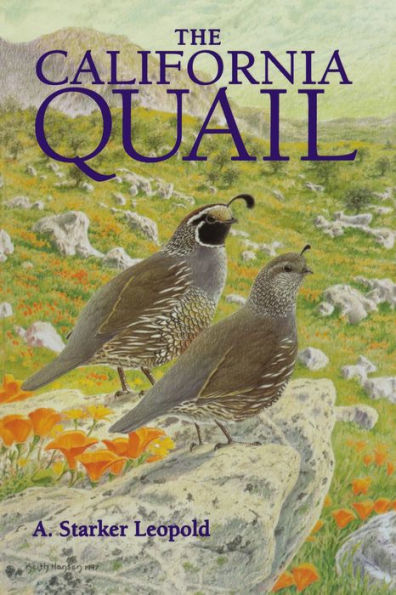The California Quail
We all recognize the California Quail, with its striking good looks and mellow call notes. Widely distributed along the whole Pacific Coast, it has long been of interest to bird-lovers, sportsmen, ranchers, and wildlife biologists. In early times it was an important food source, and stocks were rapidly depleted by market hunters. Today its populations are being restored through the efforts of both private land-owners and government agencies.
This comprehensive report summarizes what is known about the history, biology, and management of the species. It recounts the impact of settlement on quail, it describes the quail's intriguing social life, covey relationships, nesting behavior, and habitat requirements. Males, for example, play an important role in chick-rearing; chemical compounds in food substantially influence the nesting success of females. A major part of this book tells how to provide proper over, food, and drinking water that are needed to increase quail populations, whether for hunting or for observation and enjoyment. The suggestions offered stem from decades of scientific research and practical management effort.
Written by a renowned wildlife biologist who worked on the quail for many years, this volume will be the definitive work from both the natural history and game management points of view. It is copiously illustrated with photographs and drawings, and will be of use to anyone who wishes to understand and foster the state bird.
"1100002705"
This comprehensive report summarizes what is known about the history, biology, and management of the species. It recounts the impact of settlement on quail, it describes the quail's intriguing social life, covey relationships, nesting behavior, and habitat requirements. Males, for example, play an important role in chick-rearing; chemical compounds in food substantially influence the nesting success of females. A major part of this book tells how to provide proper over, food, and drinking water that are needed to increase quail populations, whether for hunting or for observation and enjoyment. The suggestions offered stem from decades of scientific research and practical management effort.
Written by a renowned wildlife biologist who worked on the quail for many years, this volume will be the definitive work from both the natural history and game management points of view. It is copiously illustrated with photographs and drawings, and will be of use to anyone who wishes to understand and foster the state bird.
The California Quail
We all recognize the California Quail, with its striking good looks and mellow call notes. Widely distributed along the whole Pacific Coast, it has long been of interest to bird-lovers, sportsmen, ranchers, and wildlife biologists. In early times it was an important food source, and stocks were rapidly depleted by market hunters. Today its populations are being restored through the efforts of both private land-owners and government agencies.
This comprehensive report summarizes what is known about the history, biology, and management of the species. It recounts the impact of settlement on quail, it describes the quail's intriguing social life, covey relationships, nesting behavior, and habitat requirements. Males, for example, play an important role in chick-rearing; chemical compounds in food substantially influence the nesting success of females. A major part of this book tells how to provide proper over, food, and drinking water that are needed to increase quail populations, whether for hunting or for observation and enjoyment. The suggestions offered stem from decades of scientific research and practical management effort.
Written by a renowned wildlife biologist who worked on the quail for many years, this volume will be the definitive work from both the natural history and game management points of view. It is copiously illustrated with photographs and drawings, and will be of use to anyone who wishes to understand and foster the state bird.
This comprehensive report summarizes what is known about the history, biology, and management of the species. It recounts the impact of settlement on quail, it describes the quail's intriguing social life, covey relationships, nesting behavior, and habitat requirements. Males, for example, play an important role in chick-rearing; chemical compounds in food substantially influence the nesting success of females. A major part of this book tells how to provide proper over, food, and drinking water that are needed to increase quail populations, whether for hunting or for observation and enjoyment. The suggestions offered stem from decades of scientific research and practical management effort.
Written by a renowned wildlife biologist who worked on the quail for many years, this volume will be the definitive work from both the natural history and game management points of view. It is copiously illustrated with photographs and drawings, and will be of use to anyone who wishes to understand and foster the state bird.
37.49
In Stock
5
1

The California Quail
304
The California Quail
304
37.49
In Stock

Product Details
| ISBN-13: | 9780520907775 |
|---|---|
| Publisher: | University of California Press |
| Publication date: | 04/28/2023 |
| Sold by: | Barnes & Noble |
| Format: | eBook |
| Pages: | 304 |
| File size: | 23 MB |
| Note: | This product may take a few minutes to download. |
About the Author
From the B&N Reads Blog
